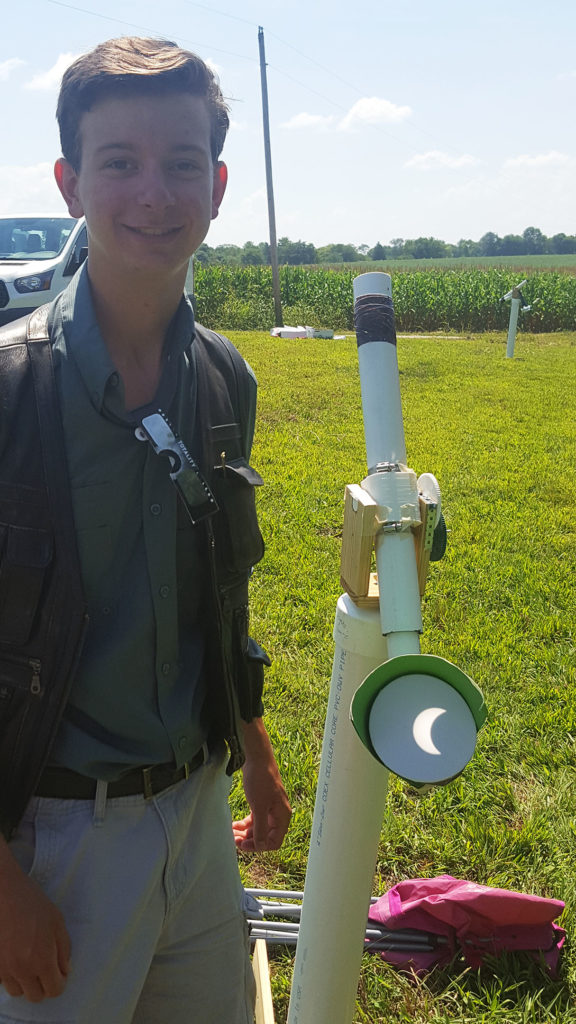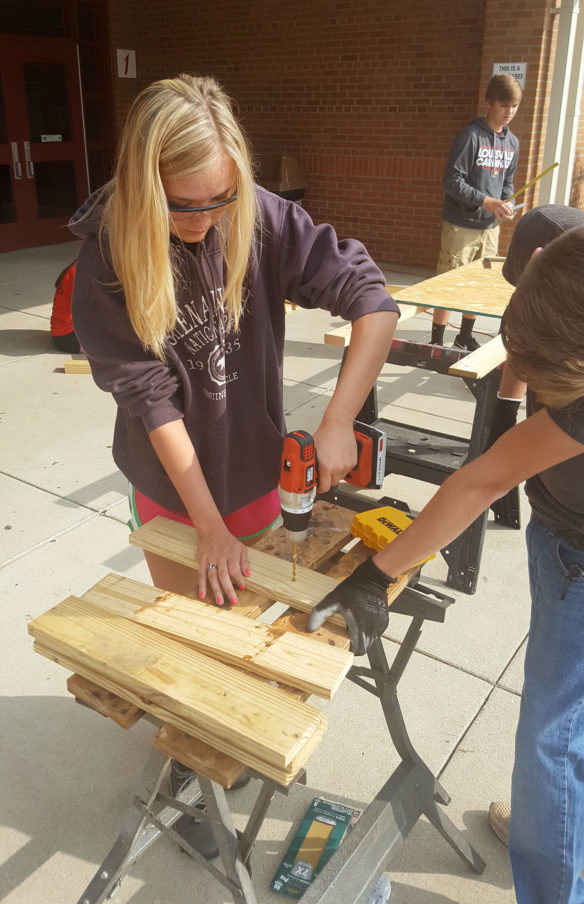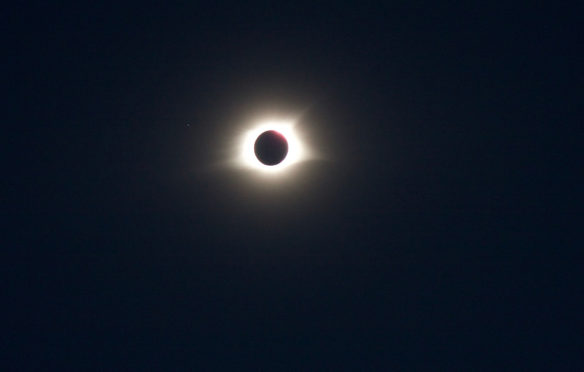
Bullitt East High School engineering student Shane Kelty shows how the Aug. 21 eclipse was visible with his PVC telescope, which includes a geared telescope mount he designed and made with a 3-D printer. Kelty was one of 14 Bullitt East engineering students that used telescopes they built to document the total solar eclipse just south of Bowling Green.
Photo submitted by Darrell Vincent
“If we wish to prepare a generation of students who can solve real-world problems, we must give them real-world problems to solve.”
– John Larmer and John R. Mergendoller from the article “The Main Course, Not Dessert,” Buck Institute for Education
The Bullitt East High School (Bullitt County) Project Lead the Way engineering program is entering its fourth year. The program incorporates a project-based approach to teaching an engineering curriculum. The engineering curriculum has allowed students to work on projects and problems of their own choosing while the teacher serves in the role of facilitator.
I am amazed at what students come up with and what they are capable of when they are inspired and excited about projects that they have a voice in. People talk about facilitating instead of teaching, but thanks to a unique opportunity provided by the Aug. 21 total solar eclipse, now I get it.
Bullitt East now has its first group of seniors enrolled in the Engineering Design and Development capstone course (EDD). EDD is a culmination of the engineering program, where students get to apply all that they have learned in previous engineering courses to develop a solution to a real-world problem of their choosing.
In May, these students were discussing with me the possibility of going on a field trip to view the total solar eclipse that would be visible in the western part of the state. I decided that this would be an excellent opportunity for them to review previous coursework in preparation for the capstone course.
In the early days of the EDD capstone class, students need to review the engineering design process, which is a problem-solving approach used by engineers. Students are required to define and justify a problem that they wish to solve. They also use Autodesk Inventor – a software package used to create 3-D models and CAD drawings – and reverse engineering, among other topics, to create and present a solution to their problem.
I saw a unique opportunity to use the solar eclipse to review the concepts the students would need to be successful in the EDD course. The students were shown a telescope made of plastic pipes (PVC) that was completed about 10 years ago under the direction of Rico Tyler, a master teacher in Western Kentucky University’s SKyTeach program. Tyler uses this design to train teachers and students in the Governors’ Scholars program how to build and use homemade telescopes.

Seniors Brooklynn Taylor and Andy Lutz work on creating parts for the telescope build. The Engineering Design and Development students were required to reverse engineer a PVC telescope, create 3-D models and technical drawings, locate the individual parts and create a manufacturing process to build a telescope for each student going on a trip to view the total solar eclipse in Western Kentucky.
Photo submitted by Darrell Vincent
The EDD students were required to reverse engineer the PVC telescope, create 3-D models and technical drawings, locate the individual parts and create a manufacturing process to build a PVC telescope for each student going on the trip. Students had to create a parts list and cost of each part as a part of the working drawings. The students determined that the cost of each of the 15 telescopes was about $70. The CAD working drawings and other documentation were shared with Tyler at WKU for his use.
Students worked several days over the summer break and met at school on one Saturday in August to use the manufacturing process that they designed to build the telescopes. The students divided themselves into two groups to complete the required work. The build team made the individual pieces and assembled the telescopes, while the CAD team created the working drawings, which listed the parts and showed the assembly process.
The students completed a PowerPoint presentation documenting their steps to reverse engineer and build the telescopes, as well as documenting the solar eclipse with their own hand-built telescope, cell phone and camera. The PowerPoint will be presented to school board members and the community to promote the engineering program in the Bullitt County school system.
This event was the epitome of project-based and teacher-facilitated learning. The students were given a project, criteria and a deadline. The students applied the engineering design process and CAD software learned in previous classes to create and even innovate the design of the PVC telescopes for viewing and documenting the eclipse.

Bullitt East engineering student Maddie Back captured the total solar eclipse that occurred on Aug. 21.
Photo by Maddie Back
Student David Vinson said traveling to a location in the path of totality was unforgettable.
“The process really made this an amazing event,” he said. “All of us had different interests and backgrounds and we worked together with a common goal. The entire experience made this a once-in-a-lifetime experience that I will never forget.”
“Watching the students’ reaction to the moment of totality was as amazing as experiencing the eclipse itself,” said Assistant Principal Kari Stewart, who helped chaperone the trip.
The Project Lead the Way engineering program has changed me as a teacher by training me to be a facilitator of learning. Facilitating students involves some risk-taking, since the students become the leaders of their own learning as opposed to the teacher just imparting knowledge in the traditional sense.
With proper preparation, students can rise to any challenge as they begin to develop a passion for learning. Project-based learning enables them to find their own answers and to solve problems of their own choosing. When students become passionate, it is amazing what they will accomplish. Project-based and teacher-facilitated learning can be replicated in any curriculum, and it is the key to igniting a passion for learning in students.
Darrell Vincent teaches AP Physics, Introduction to Engineering Design, Principles of Engineering, Digital Electronics, and Engineering Design and Development at Bullitt East High School (Bullitt County). He serves as the school’s science department chair and as a master teacher for Project Lead the Way, where he trains future engineering teachers during the summer. He holds a bachelor’s degree in physics from Western Kentucky University, and a bachelor’s in electrical engineering and a master’s degree in secondary science education from the University of Kentucky. Vincent was the Bullitt County High School Teacher of the Year in 2010-11 and a semifinalist for the Kentucky Teacher of the Year in 2011.



Leave A Comment